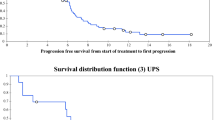Summary
Background
Olaratumab is a humanized monoclonal antiplatelet-derived growth factor receptor alpha antibody that has been approved in combination with doxorubicin for the treatment of patients with metastatic soft tissue sarcoma (STS). The purpose of this retrospective study was to assess the clinical efficacy in STS patients treated with olaratumab in a real-world setting in Austria.
Methods
Retrospectively collected longitudinal data from patients treated between November 2016 and September 2018 at 9 Austrian centers were obtained from the respective medical charts. All patients who received at least one dose of olaratumab were eligible. Parameters of most interest were response rates, progression-free survival (PFS) and overall survival (OS).
Results
Altogether 55 patients were included in the analysis. The median age was 58 years. In total, 65.5% (n = 36), 21.8% (n = 12) and 12.7% (n = 7) received olaratumab as first, second or ≥third line treatment, respectively. Olaratumab was administered either in combination with doxorubicin (81.8%, n = 45) or liposomal doxorubicin (16.4%, n = 9); one patient received olaratumab as upfront monotherapy. The median PFS and OS were 2.6 and 11.4 months, respectively. The objective response rate was 11.4% and the disease control rate was 40.9%.
Conclusion
In this real-world analysis the outcome was less pronounced compared to the results of both the phase Ib/II approval trial and the confirmatory phase III trial. The latter failed to show an improvement in OS and PFS for the doxorubicin/olaratumab combination. As such, olaratumab should not be used anymore in patients with STS.

Similar content being viewed by others
References
Fletcher CDM, Unni KK, Mertens F. World Health Organization Classification of tumours: pathology and genetics of tumours of soft tissue and bone. Lyon: IARC Press; 2002.
Siegel R, Naishadham D, Jemal A. Cancer statistics 2012. CA Cancer J Clin. 2012;62:10–29.
Skubitz KM, D’Adamo DR. Sarcoma. Mayo Clin Proc. 2007;82(11):1409–32.
Casali PG, Abecassis N, Bauer S, et al. Sort tissue and visceral sarcomas: ESMO-EURACAN Clinical Practice Guidelines for diagnosis, treatment and follow-up. Ann Oncol. 2018;29(Suppl 4):iv51–iv67.
Ng F, Boucher S, Koh S, et al. PDGF, TGF-beta, and FGF signaling is important for differentiation and growth of mesenchymal stem cells (MSCs): transcriptional profiling can identify markers and signaling pathways important in differentiation of MSCs into adipogenic, chondrogenic, and osteogenic lineages. Blood. 2008;112:295–307.
Ostman A, Heldin CH. PDGF receptors as targets in tumor treatment. Adv Cancer Res. 2007;97:247–74.
Thiery JP, Acloque H, Huang RY, et al. Epithelial-mesenchymal transitions in development and disease. Cell. 2009;139:871–90.
Kilvaer TK, Smeland E, Valkov A, et al. The VEGF- and PDGF-family of angiogenic markers have prognostic impact in soft tissue sarcomas arising in the extremities and trunk. BMC Clin Pathol. 2014;14:5.
Loizos N, Xu Y, Huber J, et al. Targeting the platelet-derived growth factor receptor alpha with a neutralizing human monoclonal antibody inhibits the growth of tumour xenografts: implications as a potential therapeutic target. Mol Cancer Ther. 2005;4:369–79.
EPAR-Product information Lartruvo®; Last Update 23/01/2018.
Tap WD, Jones RL, Van Tine BA, et al. Olaratumab and doxorubicin versus doxorubicin for treatment of soft-tissue sarcoma: an open-label phase 1b and randomised phase 2 trial. Lancet. 2016;388:488–97.
National Cancer Institute. Common Terminology Criteria for Adverse Events v.3.0 and v.4.0 (CTCAE). http://ctep.cancer.gov/protocolDevelopment/electronic_applications/ctc.htm. Accessed 14 June 2011.
Tap WD, Wagner AJ, Papai Z, et al. ANNOUNCE: A randomized, placebo (PBO)-controlled, double-blind, phase (Ph) III trial of doxorubicin (dox) + olaratumab versus dox + PBO in patients (pts) with advanced soft tissue sarcomas (STS). J Clin Oncol. 2019;37(suppl):abstr. LBA3.
EMA press release; 23 January 2019; EMA/27962/2019.
Author information
Authors and Affiliations
Contributions
A. Seeber and T. Brodowicz were involved in the design of the study and wrote the initial draft of the manuscript. Statistical analyses were done by F. Kocher and L. Weiss. All authors contributed to data collection, interpretation of results and were involved in the writing of subsequent drafts. All authors approved the final version of the manuscript.
Corresponding author
Ethics declarations
Conflict of interest
A. Seeber, L. Weiss, F. Romeder, J. Szkandera, T. Kuehr, S. Kostner, P. Pichler, T. Jaeger, F. Kocher, R. Greil, and T. Brodowicz declare that they have no competing interests.
Additional information
Publisher’s Note
Springer Nature remains neutral with regard to jurisdictional claims in published maps and institutional affiliations.
Rights and permissions
About this article
Cite this article
Seeber, A., Weiss, L., Romeder, F. et al. Olaratumab plus anthracyline in advanced/metastatic soft tissue sarcoma. Wien Klin Wochenschr 133, 21–25 (2021). https://doi.org/10.1007/s00508-019-01556-1
Received:
Revised:
Accepted:
Published:
Issue Date:
DOI: https://doi.org/10.1007/s00508-019-01556-1




